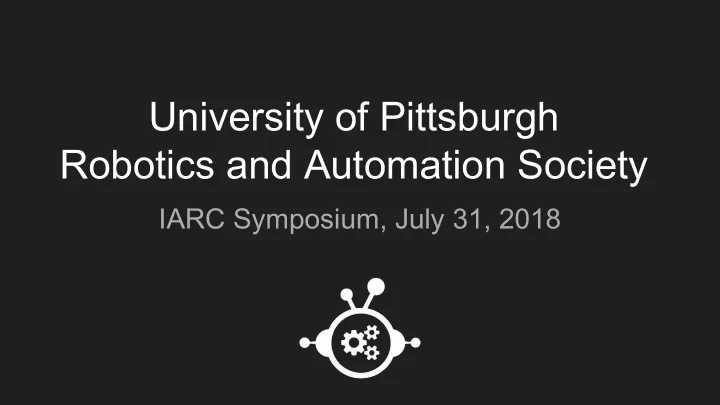

University of Pittsburgh Robotics and Automation Society IARC Symposium, July 31, 2018
Mechanical Design Presentation Outline ● Mechanical overview ● Roomba Bumper ● Propulsion System Electrical Systems ● System Overview ● Computers and Microcontrollers ● Safety Switch State Estimation and Control ● Motion Control ● Obstacle Detection ● Target Detection ● Position Estimation Testing ● Integration Testing ● Half Scale Arena
Mechanical Design ● Focus on durability and extensibility ● Laser cut plywood roomba bumper ○ Lightweight and strong ● Carbon fiber center frame ● Quick Facts ○ 4.5kg (10lbs) ○ 7 minute flight time ○ 1.2 meters across ○ 12x6 APC props ○ 25.2V, 10.4 Ah motor battery ○ 2 kW average power usage
Electronic Systems: System Overview
Electronic Systems: Safety Switch ● One-Shot PWM to DC converter ● Capable of 120A peak, 80A continuous without significant heat rise ○ Low Rds-on ensures minimal power waste ● Simple design and construction provides robust operation and no failures to date
State Estimation and Control: Overview Core Software Components ● Motion Planner and Trajectory Control ● Obstacle Detector and Kalman Filter ● Target Detector and Kalman Filter ● Position Estimation ● Safety Monitor ● Localization Extended Kalman Filter
State Estimation and Control: Position Estimation Optical Flow: ● Custom optical flow implementation ● Statistical filter monitors flow health ● Ignores vectors on ground targets Arena Detection: ● Texture classification using SVM ● 41 filters including color and derivatives ● Linear SVM finds boundary line Fused with IMU measurements in Extended Kalman Filter
State Estimation and Control: Motion Control Motion Planner: ● Architecture for motion primitives ● Support for search based planner Trajectory Controller: ● PID on velocity with feedforward ● Nonlinear, dynamic thrust model ○ Reduces rotor lag by 40ms ○ Increases thrust slew rate by 4 times ● Applies acceleration setpoints ○ Not supported by current flight controllers ○ Significantly decreases control lag
Software: Obstacle Detection and Avoidance Detection ● Based on depth images received from Intel’s R and D series Realsense cameras ● DBSCAN clustering to find individual obstacles Avoidance ● Potential field to prohibit velocities which would bring the drone too close to any obstacle
Software: Target Detection ● Bottom camera detector ● Side camera detector ○ Classical computer vision techniques ○ CNN based on modified Tiny ○ HSV normalization and threshold, YOLO architecture morphology operations
Testing: Integration Simulation: ● Uses the MORSE simulator ● Physics, textures, most sensors ● Virtual Roombas Crazyflie: ● Full software stack run on laptop ● Introduces stochastic variation ● Used primarily for testing controls
Testing: Quarter Scale Arena Accomplished Behaviours: ● Stable Trajectory Control ● Arena Boundary Detection ● Search-based trajectory planning for jerk limits ● Target Interaction (Hit and Block) ● Obstacle Avoidance
Thank you to our sponsors!
Software: Motion Planning ● Planning for various tasks accomplished by a heuristic search based planner ● Accounts for both obstacles within the arena and the dynamic constraints of the drone ● Uses anytime search with bounded sub-optimality to achieve real-time performance
Software: Localization Vertical Orientation ● Long-range lidar ● IMU onboard flight controller, ● Short-range lidar fused with Mahony filter ● Accelerometer ● Grid orientation fused with complementary filter Horizontal Fusion ● Accelerometer ● Sparse Optical Flow (OpenCV ● 15DOF Extended Kalman Filter Lucas-Kanade) (robot_localization) ● Complementary filters fusing velocities
Electronic Systems: Computers and Microcontrollers Main computers: Supporting microcontrollers: ● NVIDIA Jetson TX2 ● Seriously Pro Racing F3 EVO ○ Onboard GPU for low latency roomba ○ Cortex M3 Flight Controller board identification and optical flow with integrated IMU ○ CPU used for state estimation, motion ● Teensy 3.2 planning, and controls ○ Relays Lidar range finder readings ● Intel NUC (i7-6770HQ) ● Arduino Nano ○ High USB bandwidth used to connect ○ Relays battery voltage over 4 Intel Realsense depth cameras opto-isolated serial link ○ Processes point clouds ○ Estimates obstacle positions
Motion Control: Height Holding
State Estimation and Control: Motion Control Static Model Nonlinear Dynamic Model
Recommend
More recommend